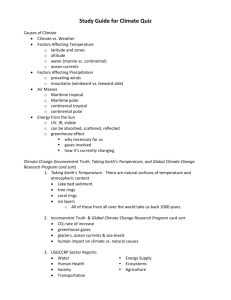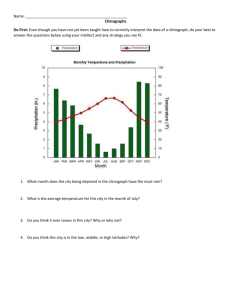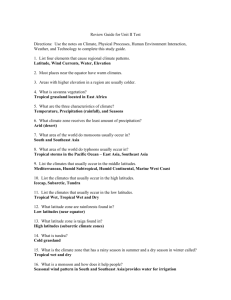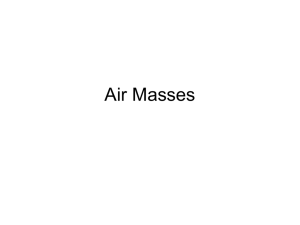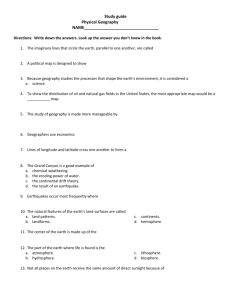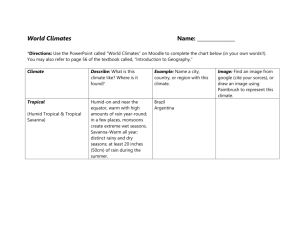World Climate and Vegetation Zones (revised)
advertisement
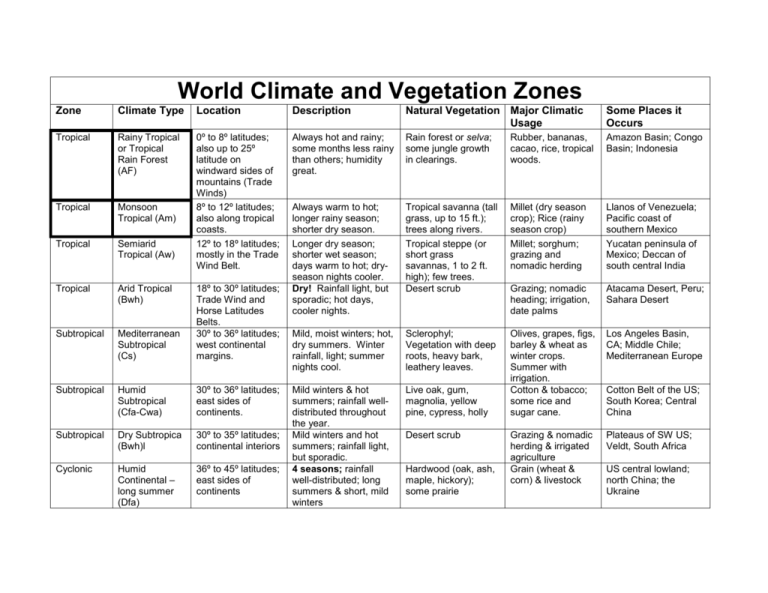
World Climate and Vegetation Zones Zone Climate Type Location Description Natural Vegetation Major Climatic Usage Some Places it Occurs Tropical Rainy Tropical or Tropical Rain Forest (AF) Always hot and rainy; some months less rainy than others; humidity great. Rain forest or selva; some jungle growth in clearings. Rubber, bananas, cacao, rice, tropical woods. Amazon Basin; Congo Basin; Indonesia Tropical Monsoon Tropical (Am) Tropical Semiarid Tropical (Aw) 0º to 8º latitudes; also up to 25º latitude on windward sides of mountains (Trade Winds) 8º to 12º latitudes; also along tropical coasts. 12º to 18º latitudes; mostly in the Trade Wind Belt. Llanos of Venezuela; Pacific coast of southern Mexico Yucatan peninsula of Mexico; Deccan of south central India Arid Tropical (Bwh) Grazing; nomadic heading; irrigation, date palms Atacama Desert, Peru; Sahara Desert Subtropical Mediterranean Subtropical (Cs) 18º to 30º latitudes; Trade Wind and Horse Latitudes Belts. 30º to 36º latitudes; west continental margins. Tropical savanna (tall grass, up to 15 ft.); trees along rivers. Tropical steppe (or short grass savannas, 1 to 2 ft. high); few trees. Desert scrub Millet (dry season crop); Rice (rainy season crop) Millet; sorghum; grazing and nomadic herding Tropical Always warm to hot; longer rainy season; shorter dry season. Longer dry season; shorter wet season; days warm to hot; dryseason nights cooler. Dry! Rainfall light, but sporadic; hot days, cooler nights. Mild, moist winters; hot, dry summers. Winter rainfall, light; summer nights cool. Sclerophyl; Vegetation with deep roots, heavy bark, leathery leaves. Los Angeles Basin, CA; Middle Chile; Mediterranean Europe Subtropical Humid Subtropical (Cfa-Cwa) 30º to 36º latitudes; east sides of continents. Live oak, gum, magnolia, yellow pine, cypress, holly Subtropical Dry Subtropica (Bwh)l 30º to 35º latitudes; continental interiors Humid Continental – long summer (Dfa) 36º to 45º latitudes; east sides of continents Grazing & nomadic herding & irrigated agriculture Grain (wheat & corn) & livestock Plateaus of SW US; Veldt, South Africa Cyclonic Mild winters & hot summers; rainfall welldistributed throughout the year. Mild winters and hot summers; rainfall light, but sporadic. 4 seasons; rainfall well-distributed; long summers & short, mild winters Olives, grapes, figs, barley & wheat as winter crops. Summer with irrigation. Cotton & tobacco; some rice and sugar cane. Desert scrub Hardwood (oak, ash, maple, hickory); some prairie Cotton Belt of the US; South Korea; Central China US central lowland; north China; the Ukraine Zone Climate Type Location Description Natural Vegetation Major Climatic Usage Some places it occurs Cyclonic Humid Continental – short summer (Dfb-Dwb) 45º to 55º latitudes; east sides of continents. Hardwood & evergreen (pine, fir, spruce). Dairying; hay & small grains; lumbering St. Lawrence Valley; Baltic Plain; Manchuria Cyclonic Dry Continental (Bwk) 36º to 53º latitudes; continental interiors Temperate Marine (Marine West Coast) (Cfb) Polar Continental (Dc, Dd) 36º to 65º latitudes; western margins of continents Short grasses; dwarfed trees; desert scrub Forest (mixed); heather, shrubs, grasses Grazing; irrigated agriculture Cyclonic 4 seasons; rainfall & snowfall welldistributed. Medium summers; colder winters. Hot summers; COLD winters; rainfall light and sporadic Always mild & moist; exposed to westerly winds Great Basin of US; Mongolia; Argentine Patagonia US Northwest coast; British Isles; New Zealand Polar Marine (ET) Above 65º latitude; on Arctic & Antarctic shores exposed to the Polar Easterlies Taiga (evergreen forest) – spruce, larch, fir, tamarack, “whitewoods” Tundra – scrub, mosses, lichens. Lumbering; trapping; & furfarming (raising) Polar Hunting; trapping; fishing. Aleutian chain and Arctic lowlands of Alaska; Russian Siberian tundra Polar Polar (Ice-Cap) (EF) In the interiors of polar lands NONE NONE Greenland & Antarctica Mountains Unclassified (H) High mountains Generally, 2 seasons (change is rapid); long cold winters; short, warm summers Long , cold winters (not as cold as Polar Continental) with much darkness. Short, chilly summers (caused by the winds) Always cold; no summers; precipitation light as snow or sleet Altitudinal zonation Varies with altitude Varies with altitude Andes Polar 55º to 65º latitudes; East margins & continental interiors Dairying; lumbering
